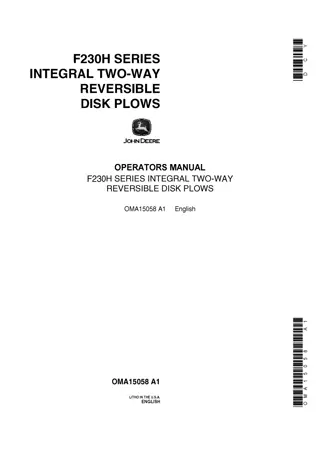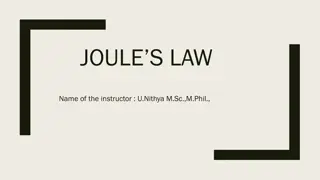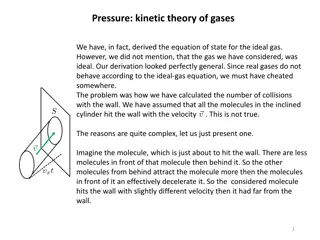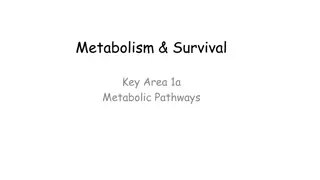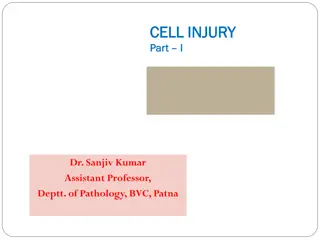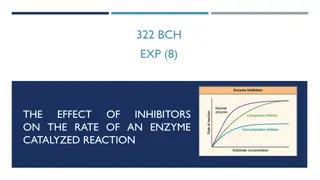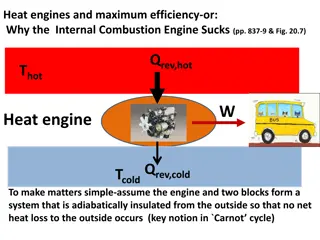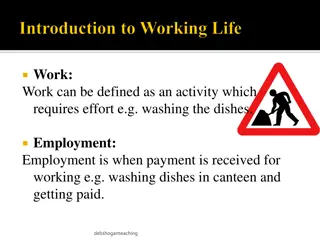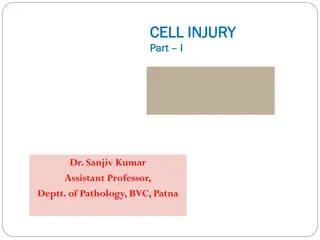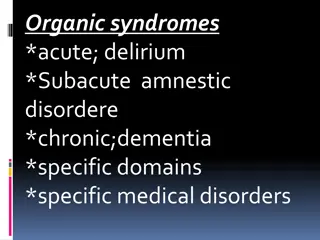Chemical equilibrium
Chemical equilibrium is a state where reactants and products reach a balance in a reaction. Learn about reversible and irreversible reactions, equilibrium constants, and how they affect chemical analysis. Discover the accuracy and applications of volumetric analysis, including titration methods like
3 views • 13 slides
Understanding Environmental Stress and Plant Management
Environmental stress, whether biotic or abiotic, can adversely affect plant growth and yield. Factors such as temperature extremes, waterlogging, radiation, chemicals, and pollution can lead to plant strains that may be reversible or permanent. Effective management of stress due to excessive moistur
8 views • 35 slides
To be able to learn how substances melt or freeze at different temperatures.
Explore the three states of matter – solid, liquid, gas – and learn about the processes of melting and freezing. Discover how substances change state based on temperature variations, such as ice melting into water or water freezing into ice. Dive into the concepts of melting point, freezing poin
6 views • 11 slides
Cryogenic Sub-systems
Explore the relationship between liquefaction, refrigeration, and isothermal processes in accelerator systems. Understand the equivalent exergy in Watts for different gases at 1 bar and 300K. Calculate the reversible input power required for latent cooling and the total cooling in different scenario
1 views • 9 slides
John Deere F230H Series Integral Two-Way Reversible Disk Plows Operator’s Manual Instant Download (Publication No.OMA15058)
Please open the website below to get the complete manual\n\n\/\/
0 views • 18 slides
Models and Concepts of Disability: Understanding the Disability Process and Components
Exploring various models and concepts of disability, this content delves into the disability process, including definitions, components, and interactions outlined by Nagi, IOM, and the ICF model. It highlights the perspective that disability is not inherent to the individual and can be preventable a
0 views • 24 slides
Understanding Reversible and Irreversible Changes in Chemistry
Exploring the concepts of reversible and irreversible changes in chemistry through examples such as heating, mixing, and burning. Reversible changes allow original materials to be recovered, while irreversible changes result in the formation of new materials. Various chemical reactions are highlight
0 views • 15 slides
Understanding Reversible and Irreversible Changes in Science
Explore the differences between reversible and irreversible changes through a crystal experiment and vocabulary development. Discover examples of reversible changes like dissolving and test various materials for solubility. Engage in designing a presentation to illustrate the contrast between revers
0 views • 13 slides
Understanding Indirect-Acting Cholinergic Drugs and Their Mechanisms of Action
This lecture covers the classification, mechanism of action, kinetics, dynamics, and uses of indirect-acting cholinomimetics. It discusses anticholinesterases, their adverse effects, contraindications, and the symptoms and treatment of organophosphates toxicity. Reversible and irreversible anticholi
2 views • 24 slides
Understanding Chemical Equilibrium in Reversible Reactions and Laws
Chemical equilibrium in reversible reactions involves the balance between forward and backward reactions, as governed by laws like the law of mass action and the law of chemical equilibrium. These laws help in understanding the rates of reactions, equilibrium constants, and the relationship between
1 views • 12 slides
Understanding Dynamic Equilibrium in Chemical Reactions
Explanation of reversible reactions, dynamic equilibrium, and the characteristics of equilibrium in chemical systems. Covers the concept of reversible reactions, dynamic equilibrium, rules for dynamic equilibrium, and examples to illustrate these concepts visually.
0 views • 54 slides
Understanding Le Chatelier's Principle in Chemical Equilibrium
Le Chatelier's Principle states that when a system at equilibrium is disturbed by changes in concentration, temperature, or pressure, the equilibrium shifts to counteract the change. This principle can be applied to predict the direction of equilibrium when changes occur. Changes in concentration, p
0 views • 10 slides
Understanding the Physiology of Shock by Professor Narsingh Verma
Shock is a critical condition resulting from poor tissue perfusion and impaired cellular metabolism. Various definitions describe it as inadequate delivery of oxygen and nutrients, leading to reversible or irreversible cellular injury. Different types of shock, such as hypovolemic shock, have common
0 views • 24 slides
Understanding Joule's Law and Gas Expansion Processes
Joule's Law states that the energy of a gas is solely dependent on temperature, not volume. This law is discussed along with differences between reversible and irreversible work, as well as isothermal and adiabatic processes. The measurements and interpretations concerning the law are explored, high
1 views • 17 slides
Understanding General Anaesthetics in Veterinary Medicine
General anaesthetics induce reversible loss of sensations and unconsciousness, crucial for effective animal surgery. The use of a combination of drugs is essential to achieve safe and rapid effects in balanced general anaesthesia. Large animals present challenges due to their anatomy, making them un
1 views • 12 slides
Insight into Kinetic Theory of Gases and Maxwell Velocity Distribution
The discussion delves into the kinetic theory of gases, highlighting the deviations from ideal gas behavior and the derivation of the Maxwell velocity distribution. It explores the intricacies of molecule-wall collisions, Maxwell's assumptions, the Gaussian distribution, and the concept of reversibl
0 views • 8 slides
Understanding Contraception: Methods, Importance, and Considerations
Contraception refers to methods used to prevent unwanted pregnancies, regulate pregnancy timing, and spacing between pregnancies. It is essential for women's reproductive health and can include barrier methods, hormonal methods, emergency contraception, and intrauterine devices. These methods are sa
3 views • 28 slides
Understanding Metabolic Pathways in Organisms
Exploring the intricate world of metabolism, this topic delves into the chemical reactions within organisms. From anabolic to catabolic pathways, enzymes play a crucial role in controlling these processes. Learn about reversible and irreversible reactions, alternative pathways, and the vital role of
1 views • 17 slides
Understanding Cell Injury and Adaptation in Pathology
Rudolph Virchow's concept of disease starting at the cellular level highlights how cells constantly face challenges in maintaining homeostasis. The plasma membrane acts as a barrier against external stressors, but when cells face excessive physiological stresses or pathological stimuli, they adapt o
0 views • 16 slides
High Frequency of Unintended Pregnancy and Contraceptive Choice Among HIV-infected African Women
Reproductive health burden in sub-Saharan Africa is significant, with high rates of unintended pregnancies among HIV-infected women. The study aims to identify predictors of contraceptive choice and address the gap in effective family planning methods to reduce unintended pregnancies. Variations in
0 views • 12 slides
Understanding Enzyme Inhibition in Biochemistry
Enzyme inhibition plays a crucial role in pharmacology and biochemistry by regulating enzymatic reactions. Inhibitors can be reversible or irreversible, affecting enzyme activity differently. Competitive, uncompetitive, and noncompetitive inhibition types are explained along with examples like diiso
0 views • 20 slides
Managing Agitation in Patients in End-of-Life Care
Understanding and managing agitation in patients during the final weeks of life is crucial for providing comfort and support. This presentation by Dr. Anne Hounsell covers key aspects such as defining agitation, identifying causes, assessing reversible factors, and implementing non-pharmacological i
0 views • 17 slides
Overview of SMX Algorithm and AES Encryption Standard
The SMX Algorithm presents a fresh approach to the avalanche effect in the Advanced Encryption Standard (AES). Initially developed to overcome the limitations of the Data Encryption Standard (DES), AES boasts improved security and efficiency, supporting key lengths of 128, 192, and 256 bits. The AES
3 views • 19 slides
Understanding Small-State Noncryptographic Pseudorandom Number Generators
Explore the design and testing of small-state noncryptographic pseudorandom number generators, including definitions, rules of thumb, chisquare tests, existing and new generators, and more. Learn about block cipher encryption, hash functions, pseudorandom number generation, reversible mixing, and re
0 views • 46 slides
Understanding Enzyme Inhibition in Acid Phosphatase Kinetics
In this experiment, the effect of inhibitors on enzymatic reactions, specifically acid phosphatase, is explored. Different types of inhibition (competitive, noncompetitive, uncompetitive) are examined, along with reversible and irreversible inhibitors. The study aims to determine the type of inhibit
1 views • 17 slides
Understanding Heat Engines and Engine Efficiency
Exploring the concept of heat engines and maximizing efficiency, specifically examining why internal combustion engines have limitations. The discussion covers reversible heat transfer, engine work, efficiency calculations, and practical application to car engines. Insights on temperature differenti
0 views • 4 slides
Understanding Generalized Heat Engines and Carnot Cycle
Generalized heat engines can be reversible or irreversible, with Carnot engines playing a crucial role in maximizing efficiency. By analyzing the heat absorption and rejection processes, we explore the impact of multiple tiny Carnot engines working together and the overall effect on the main general
0 views • 14 slides
Exploring Work and Employment Dynamics
Work involves activities that require effort, while employment entails receiving payment for work done. Employers hire workers who work for them, while self-employed individuals work for themselves. Leaving school for the working world presents challenges like time and money management, new relation
0 views • 33 slides
Understanding General Anesthetics and Anesthesia
General anesthesia induces a reversible state of CNS depression, providing sedation, amnesia, muscle relaxation, reflex suppression, and analgesia. Preanesthetic medications prepare patients for the process, including antiemetics and anticholinergics. Anesthetics are delivered via inhalation or intr
0 views • 42 slides
Understanding Cellular Injury and Its Manifestations
Cellular injury can occur due to various factors like physical trauma, chemicals, radiation, and biologic agents. This process can lead to reversible or irreversible damage in cells, affecting their normal functions and possibly leading to cell death. Manifestations of cellular injury include cellul
0 views • 9 slides
Protein Denaturation and Precipitation: Mechanisms and Effects
Protein denaturation is a process where proteins lose their native structure due to external factors like heat, strong acids, or bases. This leads to protein aggregation and precipitation. Different types of denaturation exist, including reversible and irreversible forms. Strong mineral acids can al
1 views • 21 slides
Understanding Chemical Equilibrium in Reversible Reactions
Chemical equilibrium occurs when the concentrations of reactants and products remain constant over time in a reversible reaction. Reaction rate is proportional to concentration, and equilibrium is reached when the rate of formation equals the rate of consumption in both directions. Reversible reacti
0 views • 25 slides
Understanding Cell Injury and Degeneration in Response to Various Stressors
Cell injury can result from multiple stressors such as hypoxia, physical agents, chemicals, microbes, immunologic factors, nutritional imbalances, and aging. This can lead to reversible changes (degeneration) or irreversible changes (necrosis). Types of degeneration include cloudy swelling, hydropic
0 views • 22 slides
Understanding Cell Injury and its Causes in Pathology
Rudolph Virchow's concept of disease starting at the cellular level is explored in this content, focusing on the impact of the external environment on cell equilibrium. The role of the plasma membrane as a barrier and the definitions of normal cell function, adaptation, reversible injury, irreversib
0 views • 16 slides
Comprehensive Overview of LARC Provision at Blithehale Health Centre
This detailed document provides insights into the various aspects of Long-Acting Reversible Contraception (LARC) provision at Blithehale Health Centre, covering topics such as patient identification, contraceptive methods, promotion strategies, barriers faced, and operational procedures like coil cl
0 views • 11 slides
Cabinet Pricing and Stock Guide
This detailed guide provides pricing and stock information for various types of cabinets including Wall Cabinets, Base Cabinets, Tray Cabinets, and Drawer Cabinets. It includes descriptions, dimensions, and prices for different cabinet models available in Glenwood and DWhite finishes. The guide also
0 views • 15 slides
Understanding Chemical Reactions and Catalysts
Chemical reactions involve the formation of new substances from reactants, with key processes like oxidation and reduction. Reversible reactions, endothermic and exothermic reactions, and the role of catalysts in speeding up reactions are explored. The significance of chemical symbols, formulas, and
0 views • 8 slides
Understanding Organic Syndromes: Delirium, Subacute Amnestic Disorder, and Chronic Dementia
Explore the spectrum of organic syndromes including delirium, subacute amnestic disorder, and chronic dementia. Delve into the definitions, statistics, causes, management strategies, classifications, and reversible dementias associated with these conditions.
0 views • 13 slides
Thermodynamics Tutorial: Exergy Analysis of Processes
In this tutorial, we delve into the analysis of thermodynamic processes through the concept of exergy. We explore the determination of exergy destroyed, reversible work, equilibrium temperatures, wasted work potential, and more in various scenarios involving insulated systems. Detailed calculations
0 views • 15 slides
Understanding Reversible Strain Behavior in Bi-2212 Magnet Design Literature
Literature review on the strain sensitivity of Bi-2212 wires, focusing on reversible transverse pressure strain and its impact on magnet design. Discussions on the correlation between axial and transverse strain behavior, the effects of heat treatments, and variations in strain sensitivity among man
0 views • 5 slides




